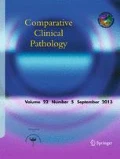Abstract
In female dogs, mammary tumors are the most common neoplasia representing about 50% of the tumors affecting this species. In women, the importance of mutations in BRCA1 and mammary tumors development is well established. However, little information is available on the molecular mechanisms that contribute to canine mammary tumors. In this work, we evaluated the mutational and methylation status of the BRCA1 gene, in tumoral and non-tumoral tissues of canine mammary glands in order to characterize its influence in mammary carcinogenesis on this species. Samples of 16 animals were collected and two hotspot regions (intron 8-exon 9 and 5′UTR) were sequenced. For methylation analysis, the bisulfite sequencing PCR approach was used. No evidence of hypermethylation was observed in the BRCA1 promoter region, suggesting this mechanism may not be involved in BRCA1 silencing in canine mammary tumorigenesis. No alteration was observed in intron 8-exon 9 region. On the other hand, two polymorphisms in the 5′UTR region were observed: a transition (T > C) that has not been previously described in the literature, and observed in one patient with an unfavorable prognosis, and the previously described transversion (C > G). We suggest that methylation is not the main BRCA1 inactivation mechanism in sporadic CMTs. Regarding the genetic alterations, two variations were detected in our population, and we were able to detect regional allele frequency differences in our population.

References
Arnesen K, Gamlem H, Glattre E, Grondalem J, Moe L, Nordstoga K (2001) The Norwegian canine cancer register 1990–1998. Eur J Companion Anim Pract 11:159–169
Bock C, Reither S, Mikeska T, Paulsen M, Walter J, Lengauer T (2005) BiQ analyzer: visualization and quality control for DNA methylation data from bisulfite sequencing. BioInformatics 21:4067–4068
Borge KS, Borresen-Dale AL, Lingaas F (2011) Identification of genetic variation in 11 candidate genes of canine mammary tumour. Vet Comp Oncol 9:241–250
Brodey RS, Goldschmidt MH, Roszel JR (1983) Canine mammary gland neoplasms. J Am Anim Hosp Assoc 19:61–89
Cassali GD, Lavalle GE, Ferreira E, Estrela-Lima A, Nardi AB, Andrigo BD et al (2014) Consensus for the diagnosis, prognosis and treatment of canine mammary tumors – 2013. Braz J Vet Pathol 7:38–69
Easton DF, Pooley KA, Dunning AM, Pharoah PD, Thompson D, Ballinger DG et al (2007) Genome wide association study identifies novel breast cancer susceptibility loci. Nature 447:1087–1093
Enginler SO, Akiş I, Toydemir TSF, Oztabak K, Haktanir D, Gündüz MC et al (2014) Genetic variations of BRCA1 and BRCA2 genes in dogs with mammary tumours. Vet Res Commun 38:21–27
Ferreira WA, Araújo MD, Anselmo NP, de Oliveira EH, Brito JR, Burbano RR et al (2015) Expression analysis of genes involved in the RB/E2F pathway in astrocytic tumors. PLoS One 10:e0137259
Foulkes WD, Shuen AY (2013) In brief: BRCA1 and BRCA2. J Pathol 230:347–349
Hall TA (1999) BioEdit: a user-friendly biological sequence alignment editor and analysis program for windows 95/98/NT. Nucleic Acids Symp Ser 41:95–98
Hopper JL, Southey MC, Dite GS, Jolley DJ, Giles GG, McCredie MR et al (1999) Population-based estimate of the average age-specific cumulative risk of breast cancer for a defined set of protein-truncating mutations in BRCA1 and BRCA2. Australian Breast Cancer Family Study. Cancer Epidemiol Biomark Prev 8:741–747
Jones PA, Baylin SB (2007) The epigenomics of cancer. Cell 128:683–692
Kent WJ (2002) BLAT-the BLAST-like alignment tool. Genome Res 12:656–664
Qiu H, Lin D (2016) Roles of DNA mutation in the coding region and DNA methylation in the 5′ flanking region of BRCA1 in canine mammary tumors. J Vet Med Sci 78:943–949
Qiu HB, Sun WD, Yang X, Jiang QY, Chen S, Lin DG (2015) Promoter mutation and reduced expression of BRCA1 in canine mammary tumors. Res Vet Sci 103:143–148
Rivera P, Melin M, Biagi T, Fall T, Haggstrom J, Lindblad-Toh K, von Euler H (2009) Mammary tumor development in dogs is associated with BRCA1 and BRCA2. Cancer Res 69:8770–8774
Sambrook J, Russell DW (2000) Molecular cloning: a laboratory manual. Cold Spring Harbor Laboratory Press, Cold Spring Harbor
Sharma S, Kelly TK, Jones PA (2010) Epigenetics in cancer. Carcinogenesis 31:27–36
Signori E, Bagni C, Papa S, Primerano B, Rinaldi M, Amaldi F, Fazio VM (2001) A somatic mutation in the 5’UTR of BRCA1 gene in sporadic breast cancer causes down modulation of translation efficiency. Oncogene 20:4596–4600
Sun W, Yang X, Qiu H, Zhang D, Wang H, Huang J, Lin D (2015) Relationship between three novel SNPs of BRCA1 and canine mammary tumors. J Vet Med Sci 77:1541–1543
Szabo CI, Wagner LA, Francisco LV, Roach JC, Argonza R, King MC, Ostrander EA (1996) Human, canine and murine BRCA1 genes: sequence comparison among species. Hum Mol Genet 5:1289–1298
Tapia T, Smalley SV, Kohen P, Munoz A, Solis LM, Corvalan A et al (2008) Promoter hypermethylation of BRCA1 correlates with absence of expression in hereditary breast cancer tumors. Epigenetics 3:157–163
Wang J, Lu C, Min D (2007) Mutation in the 5´UTR of BRCA1 in Chinese breast cancer patients. J Int Med Res 35:564–573
Acknowledgments
The authors are thankful to the anonymous reviewers of the manuscript. V.C.F, D.R.P, and L.R.V.M.A were awarded with a master fellowship from the Coordenação de Aperfeiçoamento de Pessoal de Nível Superior (CAPES) and R.M.S. was awarded with a master fellowship from CNPq.
Funding
This study was funded by the Conselho Nacional de Desenvolvimento Científico e Tecnológico (CNPq) (479667/2013-6 and 431801/2016-9) for.
Author information
Authors and Affiliations
Corresponding author
Ethics declarations
Conflicting interests
The authors declare that they have no conflict of interest.
Ethics statement
All procedures were approved by the Ethics Committee on Animal Use from Universidade Federal Rural da Amazônia (Protocol 23,084.000265/2013-53) and all animals’ owners signed a written informed consent
Rights and permissions
About this article
Cite this article
da Costa Ferreira, V., Pinheiro, D.d., de Sousa, R.M. et al. Methylation pattern and mutational status of BRCA1 in canine mammary tumors in a Brazilian population. Comp Clin Pathol 28, 63–67 (2019). https://doi.org/10.1007/s00580-018-2833-z
Received:
Accepted:
Published:
Issue Date:
DOI: https://doi.org/10.1007/s00580-018-2833-z

